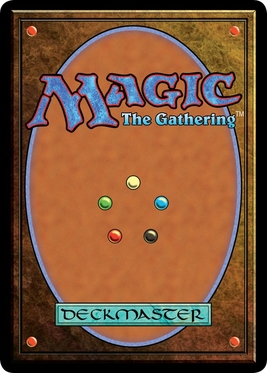
Magic: The Gathering is a tabletop and digital collectible card game created by Richard Garfield. Released in 1993 by Wizards of the Coast, Magic was the first trading card game and had approximately fifty million players as of February 2023. Over twenty billion Magic cards were produced in the period from 2008 to 2016, during which time it grew in popularity. As of the 2022 fiscal year, Magic generates over $1 billion in revenue annually.

In collectible card games, digital collectible card games and collectible miniature wargames, a booster pack is a sealed package of cards or figurines, designed to add to a player's collection. A box of multiple booster packs is referred to as a booster box.
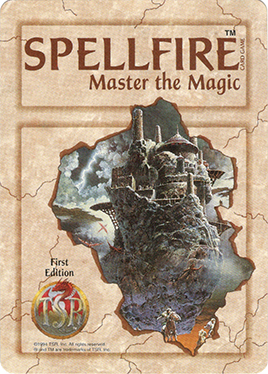
Spellfire: Master the Magic is an out-of-print collectible card game (CCG) created by TSR, Inc. and based on their popular Dungeons & Dragons role playing game. The game appeared first in April 1994, shortly after the introduction of Magic: The Gathering, in the wake of the success enjoyed by trading card games. It was the second CCG to be released, preceding Wizards of the Coast's second CCG Jyhad by two months. More than one dozen expansions for the game were released, and the final expansion was released in October 1997.
Vampire: The Eternal Struggle is a multiplayer collectible card game published by Wizards of the Coast (1994-1996), then White Wolf Publishing (1996-2010) and after several years of hiatus, by Black Chantry Productions (2018-present). It is set in the World of Darkness and is based on the Vampire: The Masquerade roleplaying game.
The collectible card game Magic: The Gathering published nine base sets from 1993–2007, also referred to as core sets. The base sets were considered descendants of the original Limited Edition, and shaped the default setting and feel of Magic. These sets consisted entirely of reprinted cards. These cards were generally simpler than cards in expansion sets, omitting multicolored cards, and used only the original abilities and keywords of Magic such as Flying and Trample. This simplicity led to many cards from these sets being considered "staples" of deck design. All cards were given a white border to mark them as reprints, with a few exceptions. From Fourth Edition in 1995 onward, a new base set would come out once per two years in the spring or early summer; for tournament play, that set would be legal for two years in the Standard format until the next core set replaced it.

The Harry Potter Trading Card Game is an out-of-print collectible card game based in the world of J. K. Rowling's Harry Potter novels. Created by Wizards of the Coast in August 2001, the game was designed to compete with the Yu-Gi-Oh!, Pokémon and Magic: The Gathering card games. Its release was timed to coincide with the theatrical premiere of the first film in the series. The game was praised for the way it immersed children in the Harry Potter universe. At one point the game was the second best selling toy in the United States; however, it is now out of print.
Navia Dratp is a collectible miniatures game with similarities to shogi, the Japanese equivalent of chess. See also chess variants for similar games.

The World of Warcraft Trading Card Game is an out-of-print collectible card game based on Blizzard Entertainment's MMORPG, World of Warcraft. The game was announced by Upper Deck Entertainment on August 18, 2005 and released on October 25, 2006. Players can play against each other one-on-one, or can join others in order to defeat dungeon/raid "bosses" based on those in the MMORPG. In March 2010, Upper Deck lost the license from Blizzard Entertainment. The license was acquired by Cryptozoic Entertainment later in the month, with the company announcing that planned card sets would be released.
Starter is the name of two Magic: The Gathering starter-level sets. The first Starter was released on August 27, 1999 and was the fourth starter level set. It was followed by Starter 2000, the fifth and final starter set, on April 24, 2000.

On The Edge is an out-of-print collectible card game released in 1994, not long after Magic: The Gathering. The setting and characters were based on the RPG titled Over the Edge. The game's story was set on an island in the southern Mediterranean called Al Amarja, where various factions were fighting for control.

Dune is an out-of-print collectible card game produced by Last Unicorn Games and Five Rings Publishing Group, and later Wizards of the Coast. Set in the Dune universe based on the books written by Frank Herbert, the game pits two or more players against each other, each in control of a minor house vying for entry in the Landsraad.
Magic: The Gathering formats are various ways in which the Magic: The Gathering collectible card game can be played. Each format provides rules for deck construction and gameplay, with many confining the pool of permitted cards to those released in a specified group of Magic card sets. The Wizards Play Network, the governing body that oversees official Magic competitive play, categorizes its tournament formats into Constructed and Limited. Additionally, there are many casual formats with the Commander format being one of the most popular formats of the game.

The Bleach Trading Card Game is an out-of-print collectible card game from Score Entertainment, and is based on the manga and anime series of the same name. The game received a nomination for Origin's "Game of the Year" and earned a semi-finalist position.
The Dragon Ball Collectible Card Game is a collectible card game based on the Dragon Ball franchise, first published by Bandai on July 18, 2008.
Killer Bunnies and the Journey to Jupiter is a 2008 board game with a non-collectible card game element created by Jeff Bellinger as a sequel to his game, Killer Bunnies and the Quest for the Magic Carrot, and published by Playroom Entertainment.
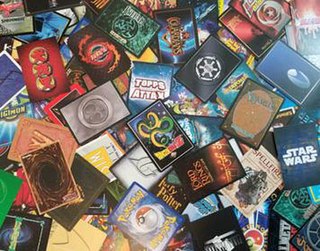
A collectible card game (CCG), also called a trading card game (TCG) among other names, is a type of card game that mixes strategic deck building elements with features of trading cards. It was introduced with Magic: The Gathering in 1993.
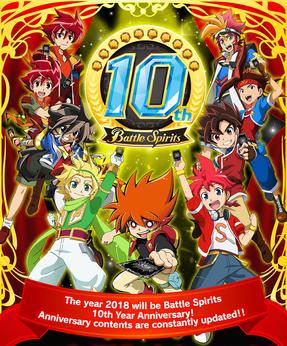
Battle Spirits is a two-player collectible card game (CCG) jointly developed by Bandai and Sunrise, Inc. and a franchise which also includes several anime series, manga serialisations, and other merchandise like toys and video games.
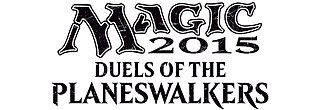
Magic 2015 – Duels of the Planeswalkers is a video game based on the collectible card game of the same name, first published by Wizards of the Coast in 1993. The game was released in July 2014 on PC (Steam), Xbox 360, iPad (iTunes), and Android devices. An Xbox One version was released in November 2014. It is the fifth game in the Magic: The Gathering – Duels of the Planeswalkers series. The gameplay follows that of the original card game, however within a more restrained framework. The game, like all the previous installments, is priced $10 on most platforms. On the iPad, the game is free for the first realm but has in-app purchases for the remaining realms, more cards and additional features.
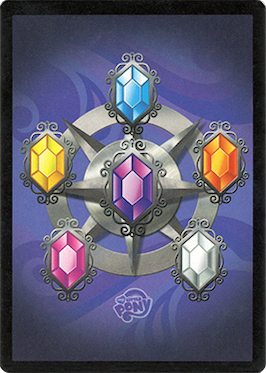
The My Little Pony Collectible Card Game is a two-player collectible card game based on the animated television series My Little Pony: Friendship Is Magic. It is produced by Enterplay LLC under license from Hasbro, and follows from Enterplay's previous work to produce a trading card series based on the same show.

Towers in Time is an out-of-print collectible card game by Thunder Castle Games that was released in April 1995. The base set had 150 cards with 56-card starter decks and 8-card booster packs. In 1996, the game was repackaged as a dedicated deck card game to be sold in a box set of 150 cards. Thunder Castle Games announced at least four expansions for the game but none of them ever materialized: Greek, Zodiac, Amazon, and Norse.













